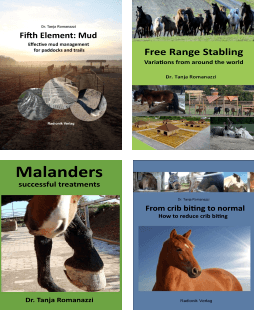PADDOCK TRAIL
Concepts of paddock paradise and paddock trail, two examples from Gut Heinrichshof
ACTIVE STABLE
Forage a concentrate feeding by computer-operated stations, individual feeding in a herd
OUR EBOOKS
Different ebooks about free range stabling, crib biting, malanders, ...
Why choose free range stabling?
If you went to the zoo and saw a large animal cooped up in a small cage, you would find that cruel. Unfortunately, regarding horses we have got used to this sight, even though this type of stabling is completely unsuitable for an animal with such a highly developed flight instinct. This results in a number of diseases and behavioral disorders.
Horses don’t just exist to be used by human beings, they have their own needs and we should provide for these as much as possible. In my opinion, every living creature has a right to its own life, aside from its potential use for humans. And this simply isn’t possible in a small stall.
What should a good free range stable provide?
Keeping them in a far too small space, with too few feeding spots or keeping them on a muddy wasteland does the horses no good. Appropriate free range stabling involves a lot more than just removing the dividing walls from the stalls. To guarantee the horses’ well-being, a free range stable should fulfill the following criteria:
Sufficient space to allow the animals to retreat
- Horses are herd animals and live in hierarchically structured groups. In the natural state, there is always enough space to allow the horses to retreat.
- If a group of horses is kept in a confined space, the lower ranking horses need sufficient space to retreat if necessary. There should be no blind corners or bottlenecks.
- All horses should be able to feed in peace. There should be a sufficient number of feeding spots to allow even the lowest ranking member of the herd to feed without stress.
- The sheltered rest areas should be designed so as to allow the lower ranking horses to lie down safely. Unfortunately, in many free range stables, only the high ranking horses lie down, which often goes unnoticed. Installing a camera can be helpful.
Constant feeding without getting fat
- Horses feed constantly, their digestive tract is designed for a constant supply of food.
- Forage feeding should therefore be planned to avoid forced feeding breaks of over 4 hours. At the same time, you don’t want your horses to get fat. The greatest challenge in good free range stabling is, in my opinion, fulfilling both of these conditions and a lot depends on the quality of your hay.
Suitable ground materials
- Horses are animals of the steppe and don’t like standing around in the mud 24 hours a day. If necessary, you may need to pave the grounds in front of the shed, around the hay racks and on the main tracks.
- Soft bedding should be available in the rest areas. This requirement is also part of animal protection laws. Hard rubber matting does not fulfill this criteria.
Responsibility towards the environment
Planning a new free range stable involves a wealth of opportunities for creating new wildlife habitats. And it is so much nicer for the horses to live in a healthy environment with buzzing bees and singing birds and any amount of silent little inhabitants peeking out from behind a blade of grass.
If this has aroused your curiosity and you would like to construct your own free range stable for your horses, we will be happy to support you with ideas and suggestions. Besides the information provided by this website, we also offer individual free range stabling consultation as well as an entire range of books and ebooks on a number of topics.

